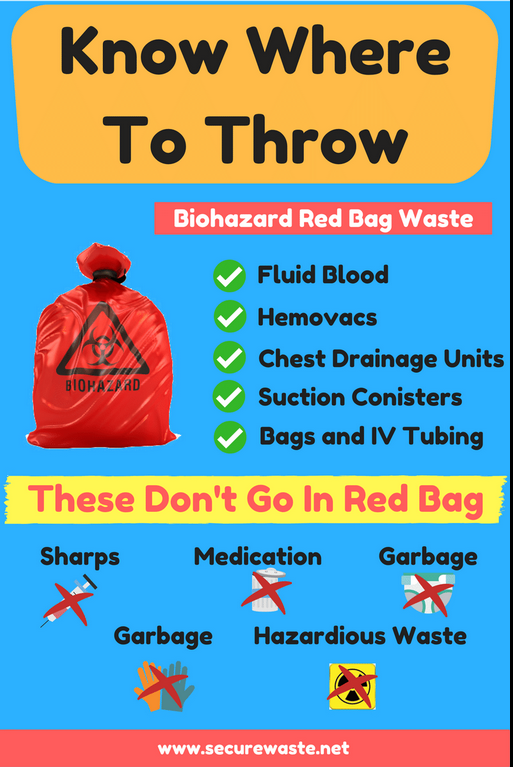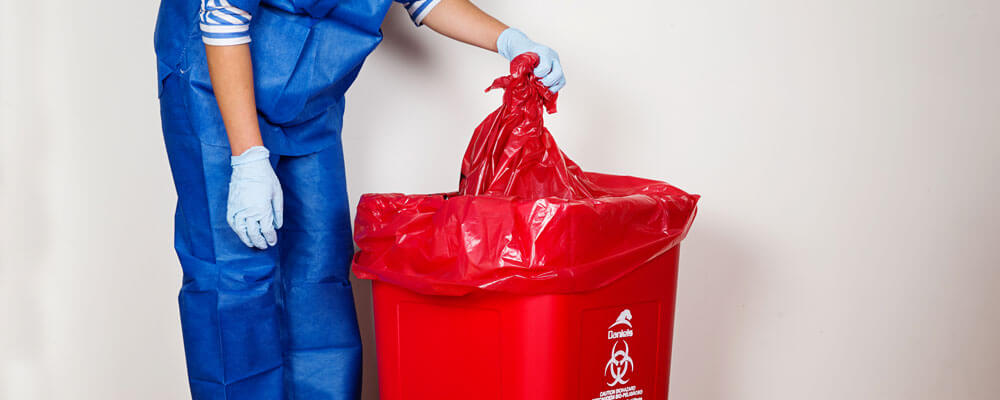Medical Waste Removal Quality: Elevating Security Specifications in Your Center
Wiki Article
Keep Ahead of Rules: Expert Guidance on Medical Garbage Disposal
In a globe where the medical care sector is constantly advancing, it is important for medical centers to stay ahead of regulations when it comes to the correct disposal of clinical waste. From comprehending the different groups of medical waste to executing the right collection and segregation approaches, this conversation will provide useful insights and actionable suggestions to assist centers remain in advance of regulations in the ever-changing landscape of medical waste disposal.Comprehending Medical Waste Categories
Understanding clinical waste categories is crucial for proper disposal and management in medical care centers. Clinical waste describes any kind of waste produced by health care activities that may posture a risk to public health or the environment. It is vital to categorize medical waste accurately to guarantee its secure handling, disposal, treatment, and transportation.There are several classifications of medical waste that health care facilities require to be acquainted with. The most usual categories consist of contagious waste, pathological waste, sharps waste, pharmaceutical waste, and chemical waste. Each group has certain standards and regulations for its appropriate management and disposal.
Pathological waste refers to human tissues, organs, or body parts that require unique handling and disposal. Drug waste consists of run out, extra, or polluted medications that need cautious handling and disposal.
Staying Up-To-Date With Regulatory Modifications
Staying current with governing adjustments is important for health care facilities to ensure conformity and correct monitoring of clinical waste disposal. medical waste removal. With laws frequently progressing, it is necessary for health care facilities to remain updated to prevent fines, fines, and potential injury to the atmosphere and public healthTo remain ahead of regulatory adjustments, health care facilities need to establish a system for monitoring and monitoring updates. This can be done by registering for regulative e-newsletters, going to workshops and meetings, and proactively getting involved in sector associations. Additionally, facilities need to mark a personnel participant or group in charge of remaining notified and disseminating info to relevant stakeholders.
Routine interaction with regulative firms is also essential. Health care facilities ought to establish partnerships with local, state, and federal firms to ensure they understand any modifications in regulations that may influence their waste management practices. This can be done via regular meetings, involvement in public remark periods, and proactive involvement with governing agencies.
Moreover, healthcare centers ought to take into consideration partnering with waste administration companies that focus on medical waste disposal (medical waste disposal services with WasteX). These firms are typically skilled in the most recent regulations and can supply advice and assistance to ensure compliance
Executing Correct Collection and Segregation Techniques
To successfully take care of clinical garbage disposal, health care facilities must establish proper collection and segregation methods based on regulative guidelines. Carrying out these techniques makes sure the risk-free handling and disposal of potentially hazardous materials, safeguards the environment, and minimizes the risk of infections and injuries to health care employees and the general public.
Appropriate collection and segregation methods involve making use of marked containers and classifying systems. Healthcare facilities should provide plainly identified containers for various kinds of clinical waste, such as sharps, contagious waste, pharmaceutical waste, and non-hazardous waste. These containers ought to be color-coded and clearly significant to stay clear of confusion and advertise simple identification.
Additionally, medical care centers must educate their staff on the correct treatments for gathering and segregating clinical waste. This consists of informing them on the different sorts of waste, the suitable containers to use, and the importance of adhering to standards and policies. Regular Your Domain Name training sessions and correspondence course must be conducted to make certain that personnel stay up-to-date on best techniques.
Moreover, healthcare centers should develop a system for regular collection and disposal of clinical waste. This may entail partnering with certified waste monitoring companies that concentrate on medical garbage disposal. These companies will certainly ensure that the gathered waste is carried and thrown away in compliance with governing requirements.
Selecting the Right Disposal Approaches

Incineration is among one of the most efficient and usual approaches for getting rid of specific types of clinical waste, such as pathological waste and sharps. It entails the regulated burning of waste at high temperatures, reducing it to ash. Nonetheless, incineration can release damaging contaminants into the air and add to air pollution.

Chemical treatment includes the usage of chemicals to disinfect and reduce the effects of the waste. Microwave therapy utilizes microwave power to warm and disinfect the waste.
Making Certain Conformity Via Documents and Training
After meticulously considering the appropriate disposal methods for medical waste, healthcare facilities must guarantee compliance with regulations and lessen ecological effect by carrying out efficient paperwork and training procedures. This step is essential in keeping a lasting and risk-free environment for both healthcare employees and the public.
Training is just as important in guaranteeing conformity with regulations. Healthcare workers that manage clinical waste should receive proper training on waste partition, handling, and disposal procedures. This training ought to cover topics such as the proper use individual safety tools, identification of different sorts of waste, and the correct disposal techniques for every waste group. By giving comprehensive training, healthcare facilities can encourage their staff look at this now to make informed decisions and minimize the risk of improper waste disposal.
Verdict
Finally, remaining in advance of guidelines in clinical garbage disposal is vital for health care facilities. medical waste removal services. Comprehending the different categories of clinical waste, remaining updated with regulatory changes, applying appropriate collection and segregation methods, choosing the appropriate disposal approaches, and making sure compliance via documents and training are all necessary steps. By following these standards, health care organizations can properly get rid of and handle of clinical waste in a responsible and risk-free mannerFrom recognizing the different classifications of medical waste to applying the ideal collection and segregation techniques, this discussion will certainly supply useful insights and actionable tips to assist facilities remain in advance of regulations in the ever-changing landscape of clinical waste disposal. - medical waste disposal services with WasteX
The anchor most common classifications include contagious waste, pathological waste, sharps waste, pharmaceutical waste, and chemical waste. Medical care centers should provide clearly identified containers for different kinds of clinical waste, such as sharps, transmittable waste, pharmaceutical waste, and non-hazardous waste. Healthcare facilities should establish an extensive system to tape-record and track all elements of medical waste disposal, consisting of types of waste produced, quantities, and disposal techniques utilized. Health care workers who deal with clinical waste ought to receive suitable training on waste segregation, dealing with, and disposal procedures.
Report this wiki page